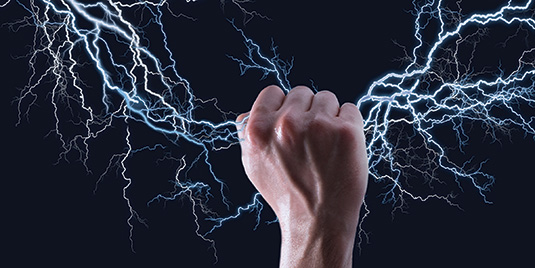
Brainwaves are detected using sensors placed on the scalp. They are divided into bandwidths to describe their functions (below), but are best thought of as a continuous spectrum of consciousness; Delta being slow, loud and functional - to Gamma being fast, subtle, and complex. It is a handy analogy to think of Brainwaves as musical notes - the low frequency waves like a deeply penetrating drum beat, while the higher frequency brainwaves are like a subtle high pitched flute.
Our brainwaves change according to what we’re doing and feeling. When slower brainwaves are dominant we can feel tired, slow, sluggish, or dreamy. The higher frequencies are dominant when we feel wired, or hyper-alert.
The descriptions that follow are only broadly descriptions - in practice things are far more complex, and brainwaves reflect different aspects when they occur in different locations in the brain.
Brainwave speed is measured in Hertz (cycles per second) and they are dived into bands deliniating slow, moderate, and fast waves.
Delta waves (.5 to 3 Hz)

Delta brainwaves are the slowest but loudest brainwaves (low frequency and deeply penetrating, like a drum beat). They are generated in deepest meditation and dreamless sleep. Delta waves suspend external awareness and are the source of empathy. Healing and regeneration are stimulated in this state, and that is why deep restorative sleep is so essential to the healing process.
Theta waves (3 to 8 Hz)

Theta brainwaves occur most often in sleep but are also dominant in the deep meditation. It acts as our gateway to learning and memory. In theta, our senses are withdrawn from the external world and focused on signals originating from within. It is that twilight state which we normally only experience fleetingly as we wake or drift off to sleep. In theta we are in a dream; vivid imagery, intuition and information beyond our normal conscious awareness. It’s where we hold our ‘stuff’, our fears, troubled history, and nightmares.
Alpha waves (8 to 12 Hz)

Alpha brainwaves are present during quietly flowing thoughts, but not quite meditation. Alpha is ‘the power of now’, being here, in the present. Alpha is the resting state for the brain. Alpha waves aid overall mental coordination, calmness, alertness, mind/body integration and learning.
Beta waves (12 to 38 Hz)

Beta brainwaves dominate our normal waking state of consciousness when attention is directed towards cognitive tasks and the outside world. Beta is a ‘fast’ activity, present when we are alert, attentive, engaged in problem solving, judgment, decision making, and engaged in focused mental activity. Beta brainwaves are further divided into three bands; Low Beta (Beta1, 12-15Hz) can be thought of as a 'fast idle, or musing. Beta (aka. Beta2, 15-22Hz) as high engagement. Hi-Beta (Beta3, 22-38Hz) is highly complex thought, integrating new experiences, high anxiety, or excitement. Continual high frequency processing is not a very efficient way to run the brain, as it takes a tremendous amount of energy.
Gamma waves (38 to 42 Hz)

Gamma brainwaves are the fastest of brain waves (high frequency, like a flute), and relate to simultaneous processing of information from different brain areas. It passes information rapidly, and as the most subtle of the brainwave frequencies, the mind has to be quiet to access it. Gamma was traditionally dismissed as 'spare brain noise' until researchers discovered it was highly active when in states of universal love, altruism, and the ‘higher virtues’. Gamma rhythms modulate perception and consciousness, disappearing under anaesthesia. Gamma is also above the frequency of neuronal firing, so how it is generated remains a mystery. The presence of Gamma relates to expanded consciousness and spiritual emergence.
What brainwaves mean to you
Our brainwave profile and our daily experience of the world are inseparable. When our brainwaves are out of balance, there will be corresponding problems in our emotional or neuro-physical health. Research has identified brainwave patterns associated with all sorts of emotional and neurological conditions. more...
Over-arousal in certain brain areas is linked with anxiety disorders, sleep problems, nightmares, hyper-vigilance, impulsive behaviour, anger/aggression, agitated depression, chronic nerve pain and spasticity. Under-arousal in certain brain areas leads to some types of depression, attention deficit, chronic pain and insomnia. A combination of under-arousal and over-arousal is seen in cases of anxiety, depression and ADHD. more...
Instabilities in brain rhythms correlate with tics, obsessive-compulsive disorder, aggressive behaviour, rage, bruxism, panic attacks, bipolar disorder, migraines, narcolepsy, epilepsy, sleep apnoea, vertigo, tinnitus, anorexia/bulimia, PMT, diabetes, hypoglycaemia and explosive behaviour. more...
Altering your brainwaves
The Manic Storm
What people do not know is that when you are facing a difficult situation, you can experience an emotional storm in your brain. When I use the word “storm”, it is not an analogy. There are actual storms inside our brains when we are full of emotion such as anger, confusion, and heartbreak. Emotion creates so much heat, like a fire and lightning storm swirling around the brain. Many people might be skeptical about how heated your brain can get just from emotion because the brain itself does not melt from emotional experiences. In other words, people do not die because they are angry. The reason is the brain has the incredible capacity to cool and protect itself against these storms. The worrisome aspect of these storms is what the heat does to the toxic heavy metals inside the brain. When you apply heat to metal, the metal becomes malleable and can run. And this is the same thing that happens with heavy metal deposits in the brain.









